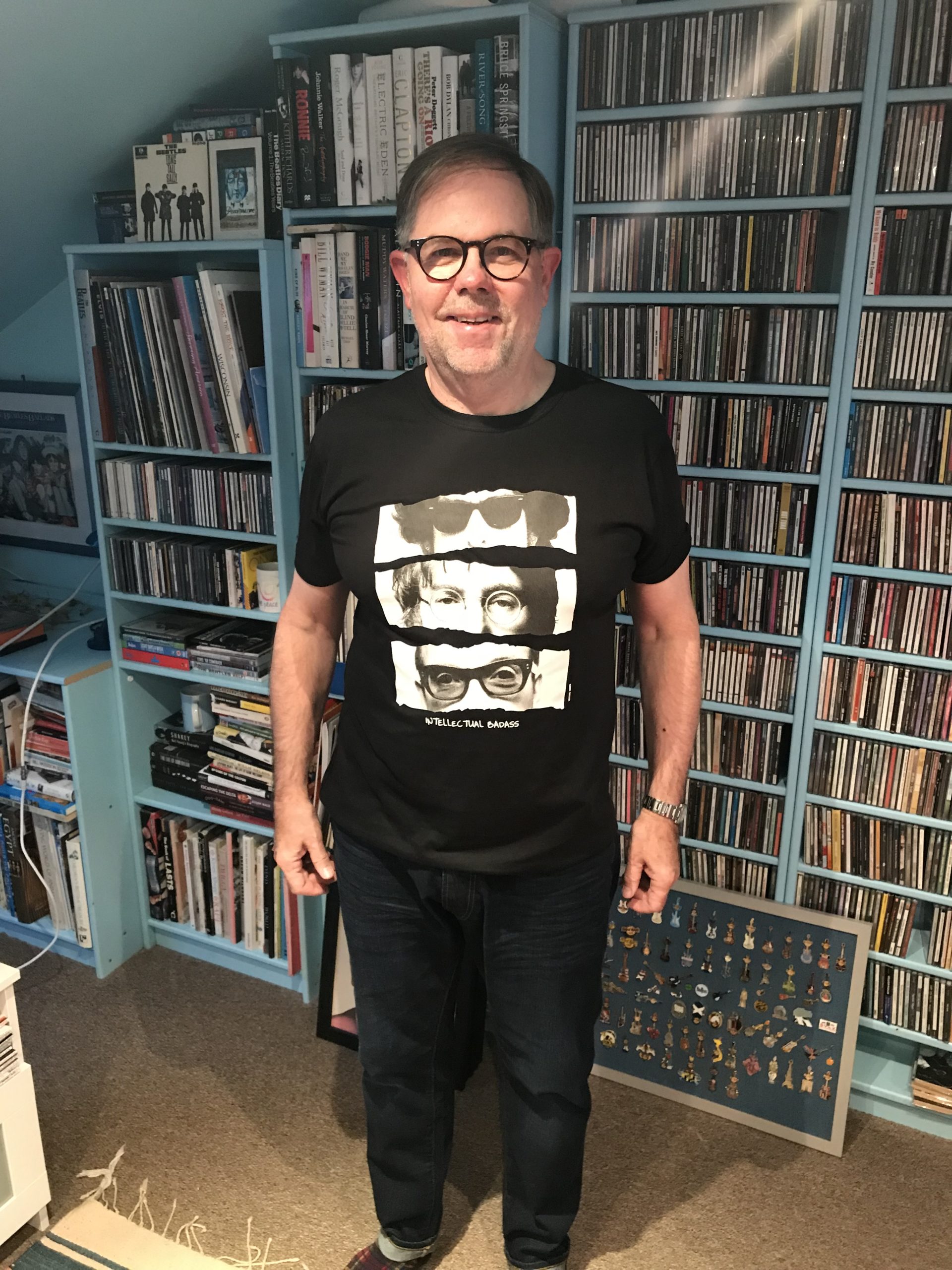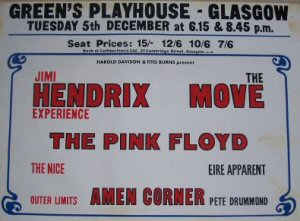The Maryland Club: Guest blog by David Beckett
On our Music Mile Tour we tell our guests about the former Maryland club, which was located in what was once a private villa and is now within the CCA in Glasgow’s Sauchiehall Street. We’re delighted to be able to share our guest blog on the club by friend of the tours, David Beckett. David contacted us after reading our previous blog on the club by Francis McKee, Director of the CCA, and naturally we jumped at the chance to find out more. We’d like to thank David for taking the time to get in touch and share his experience of the fabled venue. David has compiled a Maryland Spotify playlist and we’ll be posting this along with David’s commentary later this week.

David Beckett in his den!
GMCT: The major refurbishment of the CCA in 2001 exposed the original fabric of the building and the original villa, which housed various clubs in its day including the Maryland. When did you work there?
I worked in the Maryland between 1969 and 1971. I was the DJ, which basically meant I played album tracks between the live acts. The records I played were largely from my own collection, the collections of some of my friends and other staff members. I would play a selection by the likes of; John Mayall, Hendrix, Jefferson Airplane, Dr John, Deep Purple, Johnny Winter, Blodwyn Pig and Albert King. I was known to play very long tracks from Pink Floyd’s Ummagumma like ‘Careful With That Axe, Eugene’. When Floyd’s Atom Heart Mother was released I would play the whole album right through.
GMCT: Can you tell us more about live music at the club?
Bob Gardiner, the owner, was very keen on promoting live music and the Maryland started life as a trad jazz club in the early 60s. The club got its name from a song written by James Ryder Randall ‘Maryland, my Maryland’ usually sung to the tune of the German Christmas carol ‘O Tannenbaum’. Kid Ory’s Creole Jazz Band recorded an instrumental version in 1945 and it was a personal favourite of Bob Gardiner’s. The song went on to become a standard for many trad jazz bands including Acker Bilk, Kenny Ball and Chris Barber — it was as popular in those circles as ‘When the Saints’ and ‘Sweet Georgia Brown’. The irony of the song featuring in jazz circles is the original lyrics are pro-Confederacy: it was used during the Civil War as a battle hymn.
GMCT: How often did the club run?
The club didn’t run seven days a week — gigs were Wednesday, Friday and Saturday evenings, Sunday afternoons and occasionally Sunday evenings, the admission price ranged from twelve shillings (60p) to fifteen shillings (75p). It wasn’t licensed which was not unusual at the time — the Electric Garden in Sauchiehall Street (now the Garage) didn’t have a licence — neither did some of the famous venues in London like the 100 Club. Dope smoking did go on but it wasn’t encouraged, acid was dropped and occasionally someone would freak out. During the 60s in Glasgow, the authorities held strict puritanical views. The police raided the club twice while I was there. It was like “music off, lights on, everyone remain where you are” and you were obliged to give your name and address.
GMCT: You mentioned Bob Gardiner was into promoting live music, can you tell us more?
The Maryland really promoted emerging talent and most of the regulars appreciated that. If you went to the Maryland you knew you’d see talented musicians. Several Scottish bands played during the sixties, including The Beatstalkers, Dream Police and Dean Ford and the Gaylords (who went on to become Marmalade). TV programmes like Ready Steady Go, Juke Box Jury and of course Radio Luxembourg popularised soul and blues, which was embraced by British artists — Amen Corner, Jimmy James and the Vagabonds, Geno Washington and the Ram Jam Band all played the club.
GMCT: Did the clientele’s fashion match the music they came to hear?
It wasn’t difficult to get in but the stewards would advise a customer according to how they were dressed whether the club was their “scene”. I can only imagine what the trad jazzers wore, although my sister, who is six years older than me, was slightly associated with that crowd. They would have been the studenty, Ban the Bomb, duffel coats, and college scarf types.
The dancing crowd dressed up because it was a boy meets girl, girl meets boy scenario, you know, “to get a lumber”. The later 60s crowd was much more casual in their attire, hippy types, guys with long hair. Remember, there were still no brand names to speak of. Levis were not available prewashed. If you could afford them you had to buy them the next size up but they remained like hard cardboard for years. Desert boots and white tennis shoes (the scruffier the better) were the preferred footwear. Army surplus stores were popular with this crowd, heavy brown army greatcoats for the winter and khaki safari jackets for the summer, tie-dye three button granddad simmets. Super cool, edgy, avant garde? It’s really subjective isn’t it? I mean I thought I was cool in my khaki safari jacket with the Hieronymus Bosch book sticking out the pocket. I’m sure there would have been a lot of people thought what an eejit.
GMCT: Customers of ours who have been to the club tell differing stories about the cloakroom, some say it was a pile of coats on the floor. Is that accurate?
A pile of coats on the floor? –simply not true. The club had two cloakrooms, one for gents, one for ladies. The gent’s cloakroom was situated upstairs opposite the band’s changing room — it was usually staffed by a pensioner, affectionately known as “old John”. He normally wore a maroon wine waiter’s jacket and a bowtie. The ladies’ cloakroom and toilets were staffed by a sonsy Irish lady named Mrs Mac, I can’t remember her full name. Mrs Mac was the club’s cleaner during the week, she was often accompanied by her two teenage daughters. The musician, Fraser Spiers, was an active member of the Maryland staff during the time I was employed at the Club. Sometimes depending how busy the club was or perhaps due to staff shortages, I’d be asked to man the café bar or maybe the cloakroom. Somewhere, Fraser is on record as saying he had to help bands lifting their equipment from their vans into the premises. I suspect, like me, Fraser would on occasions be asked to help with various tasks.
GMCT: How did the music change as the 60s wore on?
The club became more of an eclectic rock venue. As the crowd changed I seem to remember the management tried to introduce the idea of a club within a club and called it Morpheus, it was a gimmick to tap into the times — the age of Aquarius and Woodstock. Friday nights were when the serious bands played, and those were the Morpheus nights. There was no sign over the door, posters advertised who was playing there on the following Friday. I think the name lasted for a couple of months before it dwindled out, everyone knew the club as the Maryland.
Bob Gardiner did promote other gigs in other venues and probably the most ambitious was in Green’s Playhouse in December 1967: on the same bill— Jimi Hendrix Experience, Pink Floyd, The Move, The Nice and Amen Corner.

From 1969 the demographic changed and the emphasis was on blues, blues-rock, folk-rock and jazz-rock. Scottish bands included Writing on the Wall, Beggars Opera, Crusade, East West, 1500 Flying Hours and Aegis.
The biggest crowds I remember were for Muddy Waters and Tony Williams’ Lifetime. Muddy Waters appeared with his full Chicago Blues Band two nights in a row. Jack Bruce was the bassist in Lifetime and in my opinion he was the huge draw. I’ve never been convinced that the Maryland crowd really liked the performance but they did turn out in droves. Jon Hiseman’s Colosseum was popular with the regulars, they played three times featuring Chris Farlowe on vocals on one occasion.
Champion Jack Dupree played in 1970 and Big Boy Arthur Crudup too — he should have been much better known and appreciated. Francis McKee mentioned Mississippi Fred McDowell in his blog — much as I would have loved to see Mississippi Fred McDowell, I have no memory of being told he had played the club and would love to find out more about that.
GMCT: As is the case with so many Glasgow venues it was a fire that ended the Maryland club, in fact the only photograph we can find of the club is of the aftermath of the fire, what do you remember about that?
The fire in the spring of 1971, in my opinion really finished the place. The club was refurbished but the ownership changed hands in 1973 and it became known as Maestro’s and then became the Cotton Club. Nearly every band I saw and heard in the Maryland had some further significance. Listed below are some of the bands that appeared between 1969 and 1971:
Edgar Broughton Band
John Dummer Blues Band
Aynsley Dunbar’s Retaliation. (Aynsley went onto to drum for Frank Zappa)
Jon Hiseman’s Colosseum (Band included Dick Heckstall Smith and Dave Greenslade. On one of their three performances at the club they featured Chris Farlowe on vocals)
Juicy Lucy
Writing on the Wall
Mott the Hoople
Uriah Heep
Stone the Crows (Maggie Bell on vocals)
Strawbs
Lindisfarne
Third Ear Band (Paul Buckmaster on cello)
Gentle Giant
Skid Row (Gary Moore on guitar)
Kevin Ayers and the Whole World (Mike Oldfield on bass)
Bridgit St John
Tony Williams Lifetime (John McLaughlin on guitar, Jack Bruce on bass).
Groundhogs
East of Eden
Gracious
Wishbone Ash
Graham Bond Organization
Pete Browns Piblokto! (Pete Brown was lyricist on a number of Cream songs)
Mike Chapman
Roy Harper
Champion Jack Dupree
Big Boy Arthur Crudup
Muddy Waters Blues Band.
Look out for David’s playlist coming later this week! Again we’d like to extend huge thanks to David for taking the time to pull this together, it’s been fascinating for us, not least because now we can repudiate the claim about a pile of coats on the floor!
